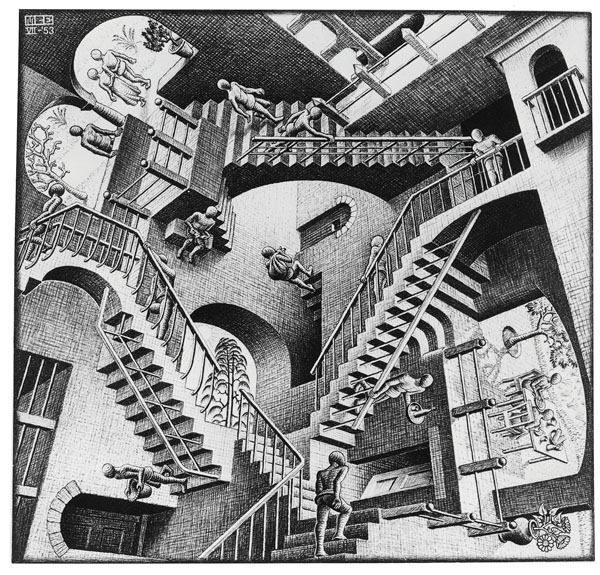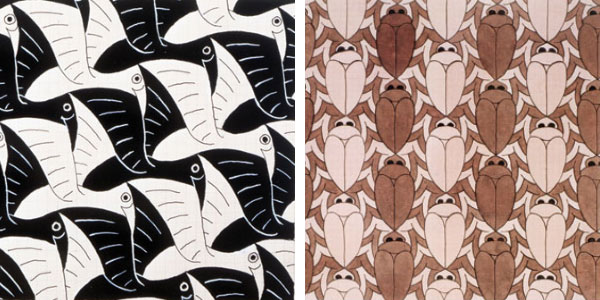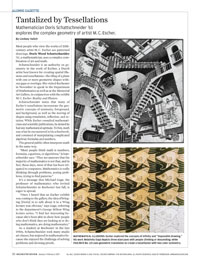Alumni Gazette
 MATHEMATICAL ILLUSIONS: Escher explored the concepts of infinity and “impossible drawing.” His work Relativity (top) depicts three staircases with people climbing or descending; while Fish/Bird No. 121 (below) uses geometric translation to create a tessellation with two-color symmetry. (Photo: All M.C. Escher works © 2016 The M.C. Escher Company—the Netherlands. All rights reserved. Used by permission. www.mcescher.com)
MATHEMATICAL ILLUSIONS: Escher explored the concepts of infinity and “impossible drawing.” His work Relativity (top) depicts three staircases with people climbing or descending; while Fish/Bird No. 121 (below) uses geometric translation to create a tessellation with two-color symmetry. (Photo: All M.C. Escher works © 2016 The M.C. Escher Company—the Netherlands. All rights reserved. Used by permission. www.mcescher.com)Most people who view the works of 20th-century artist M. C. Escher see patterned drawings. Doris Wood Schattschneider ’61, a mathematician, sees a complex combination of art and math.
Schattschneider is an authority on geometry in the work of Escher, a Dutch artist best known for creating spatial illusions and tessellations—the tiling of a plane with one or more geometric shapes without gaps or overlaps. She visited Rochester in November to speak in the Department of Mathematics as well as at the Memorial Art Gallery, in conjunction with the exhibit M. C. Escher: Reality and Illusion.
Schattschneider notes that many of Escher’s tessellations incorporate the geometric concepts of symmetry, foreground, and background, as well as the moving of shapes using translation, reflection, and rotation. While Escher consulted mathematicians and scientific publications, he denied he had any mathematical aptitude. To him, math was what he encountered in his schoolwork, and consisted of manipulating complicated algebraic formulas and numbers.
The general public often interprets math in the same way.
“Most people think math is numbers, formulas, equations, or algorithms,” Schattschneider says. “They are unaware that the majority of mathematics is not that, and in fact, these days, most of that has been relegated to computers. Mathematics is really thinking through problems, posing problems, trying to find patterns.”
It’s a message that Michael Gage, the professor of mathematics who invited Schattschneider to Rochester last fall, is eager to spread.
“Once I heard that an Escher exhibit was coming to the gallery, the idea of bringing [Doris] in to talk about it in a Wing lecture was obvious,” says Gage, referring to the department’s George Milton Wing lecture series. “I find her interesting because she’s been able to show how people who don’t think they are looking at or doing mathematics, are doing mathematics.”

 Bird No. 74 (detail, left), is based on a parallelogram. Beetle No. 91 (detail, right), is based on a rhombus. (Photo: All M.C. Escher works © 2016 The M.C. Escher Company—the Netherlands. All rights reserved. Used by permission. www.mcescher.com)
Bird No. 74 (detail, left), is based on a parallelogram. Beetle No. 91 (detail, right), is based on a rhombus. (Photo: All M.C. Escher works © 2016 The M.C. Escher Company—the Netherlands. All rights reserved. Used by permission. www.mcescher.com)Schattschneider offers several tessellation “recipes,” similar to those that Escher discovered after much investigation. In general, tessellations are created either by taking a simple shape and modifying it through geometric translation (moving corresponding endpoints of opposite sides by the same distance and in the same direction); or by modifying a shape through translation and reflection (the creation of a mirror image).
Follow these recipes to create your own tessellations, manually or with software programs such as The Geometer’s Sketchpad, GeoGebra, Cabri, or TesselManaic.
Using translation

Parallelogram
- Replace two adjacent sides (a and b above) with any series of lines or curves that connect the endpoints of the sides.
- Translate the new lines or curves to their opposite sides.

Par-hexagon
- Replace three adjacent sides (a, b, and c above) with curves that connect the endpoints of the sides.
- Translate the new lines or curves to their opposite sides.
- To tile the plane, translate the tile so that opposite edges match.

Using reflection and translation
- Begin with a rhombus to create a tile with reflection symmetry.
- Replace one side of the rhombus with a curve that connects the endpoints of the side (side a above).
- Reflect that curve in a diagonal of the rhombus that meets one of those endpoints (reflect to replace side b above).
- Translate the two curves to their opposite sides.
- To tile the plane, simply translate the tile so that opposite edges match.
As a student at Rochester in the late 1950s, Schattschneider took many studio art classes, but majored in mathematics because she enjoyed the challenge of solving problems and devising proofs.
She went on to earn a PhD in mathematics at Yale and was the first female editor of Mathematics Magazine from 1981 to 1985. At Moravian College in Pennsylvania, where she taught for 34 years and is now a professor emerita, she combined her interests early on by designing a course on the mathematics of decorative art. That’s when she encountered Escher’s work for the first time.
One of the books she chose for the class was by crystallographer Carolina MacGillavry, who had collaborated with Escher to use his works to teach geology students about crystallographic patterns. The book’s preface mentioned the artist’s notebooks, and Schattschneider was intrigued to learn more about how Escher, who had little mathematical training, was able to create art that incorporated so many geometric principles.
During a trip to The Hague in the Netherlands in 1976, she spent time photographing Escher’s notebooks. She first presented her photographs at a 1985 conference in Italy, but encountered a shortage of literature regarding the mathematical depth of Escher’s works.
“There were some wonderful books about Escher’s graphic works and about his life, but the symmetry work was barely mentioned,” she says. “I finally figured out that if someone was going to write the book, it had to be me.”
She received funding from the National Endowment for the Humanities and took a sabbatical from 1988 to 1989 to study Escher’s works at museums in the Netherlands, Washington, D.C, and Connecticut. In 1990, she published M. C. Escher: Visions of Symmetry (W. H. Freeman & Co.). A second edition was released by Harry N. Abrams in 2004.
Schattschneider continues to lecture extensively about the complexity of Escher’s works.
“It’s very unique art, and it’s the kind of art that you can’t just look at cursorily. You need to go back again and again and look closely,” she says. “If you look at some of the works really closely, you’ll just be amazed at what he was doing and how he did it.”
M. C. Escher: Reality and Illusion at the Memorial Art Gallery runs through January 29, 2017. Schattschneider lectured in the Department of Mathematics as part of the G. Milton Wing lecture series. For more information about Wing and the series, visit http://web.math.rochester.edu/news-events/wing-lectures/.

